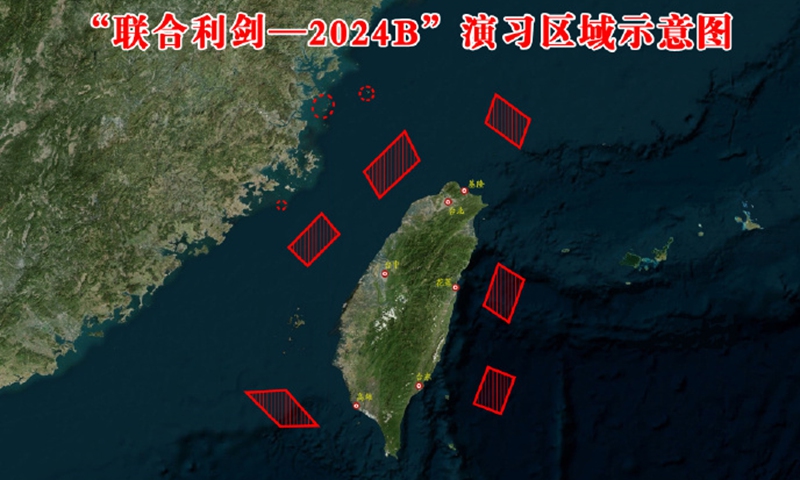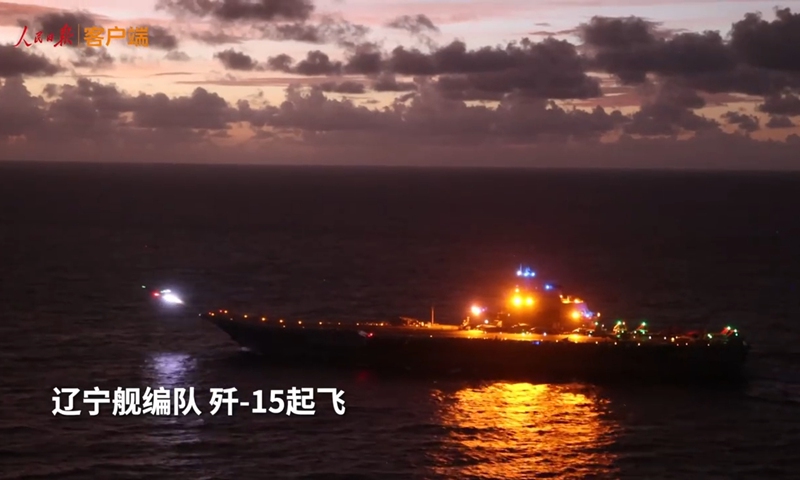Update: PLA conducts joint drill surrounding Taiwan island to send stern warning to 'Taiwan independence' separatists

The Eastern Theater Command of the Chinese People's Liberation Army (PLA) holds the Joint Sword-2024B exercises in the Taiwan Straits on October 14, 2024. Illustration: Courtesy of the PLA Eastern Theater Command
On Monday, the People's Liberation Army (PLA) Eastern Theater Command is dispatching its troops of army, navy, air force and rocket force to conduct joint military drills code-named Joint Sword-2024B in the Taiwan Straits and the drill serves as a stern warning to the separatist acts of "Taiwan Independence" forces, Senior Captain Li Xi, spokesperson of the PLA Eastern Theater Command, said in a statement released early Monday morning.
With vessels and aircraft approaching Taiwan island in close proximity from different directions, troops of multiple services engage in joint drills, focusing on subjects of sea-air combat-readiness patrol, blockade on key ports and areas, assault on maritime and ground targets, as well as joint seizure of comprehensive superiority, so as to test the joint operations capabilities of the theater command's troops, Li said.
The drill serves as a stern warning to the separatist acts of "Taiwan Independence" forces. It is a legitimate and necessary operation for safeguarding state sovereignty and national unity, said the spokesperson.
The Monday drills came after Taiwan regional leader Lai Ching-te's speech on October 10, in which he claimed that the "People's Republic of China has no right to represent Taiwan" and that they are "not subordinate to each other."
This exercise serves as a firm response to Lai Ching-te's continued fabrication of "Taiwan independence" fallacies and his propagation of separatist agendas. The exercise stands as a strong deterrent against the provocations of separatist forces seeking "Taiwan independence" and represents a just action in defense of national sovereignty and territorial integrity, Chen Binhua, spokesperson of the State Council's Taiwan Affairs Office, said in a statement on Monday.
Senior Colonel Wu Qian, a spokesperson at the Ministry of National Defense, said on Monday these exercises are not directed at the people of Taiwan. "We are willing, with utmost sincerity and effort, to strive for peaceful reunification. However, we do not promise to renounce the use of force, and we will not leave even the slightest space for Taiwan independence," said Wu.
The PLA's Joint Sword-2024B exercise sends a clear message to "Taiwan separatists" that the more aggressively they push the separatist agenda, the greater the countermeasure they will face. The joint actions taken by the mainland on Monday also break Taiwan separatist forces' illusion that whatever they do, the mainland will refrain from taking military action, analysts said.
Multiple breakthroughs
Analysts said that the Joint Sword-2024B drills have achieved multiple significant breakthroughs, including the patrols and control operations of China Coast Guard (CCG) vessels surrounding Taiwan island, and the participation of the Liaoning aircraft carrier group in the exercise.
On Monday, CCG fleets 2901, 1305, 1303, and 2102 conducted law-enforcement patrols in the waters surrounding the Taiwan island, implementing patrol and control operations around the island. This is a concrete action to manage the Taiwan island in accordance with the one-China principle, CCG spokesperson Liu Dejun said in a statement.
The scope of deterrence in the Monday exercise has expanded, and the exercise is moving closer to the island of Taiwan in comparison to the previous ones, especially with CCG vessels conducting patrol and control operations around the island, achieving successive new breakthroughs, Zhang said.
Zhang said that the Monday exercise, with overwhelming force and strategic depth, has significantly squeezed the Taiwan military's "defense and operational space."
The PLA's naval and air forces, along with CCG, are advancing toward the Taiwan island from multiple directions, enforcing a complete blockade of the island. It is as if a sharp sword is piercing through the Taiwan authorities' so-called "defense space," drawing ever nearer to the island, fully showcasing the PLA's joint operational capabilities across multiple operational domains around Taiwan island, Zhang said.
Upon further analysis of the designated areas for this exercise, Zhang said the PLA has established six zones: two in the Taiwan Straits, two to the east of the island, one in the north, and one in the south.
Zhang noted that the drills in the northern sea and airspace serve as a direct warning to the leading figures of 'Taiwan independence," specifically targeting Lai authorities. Meanwhile, the exercises in the southern sea and airspace are designed to send a warning to the main strongholds of the "Taiwan independence" forces.
Compared to previous PLA's exercises around the Taiwan island in recent years, the deterrence scope of the current drill has expanded significantly, and the location of the drill is moving closer to the island. In response to the provocations by the "Taiwan independence" separatist forces in collusion with external powers, who employ a "salami slicing" strategy, the PLA has developed a proactive counter posture to deal with these challenges, said Zhang.
Soon after Lai's separatist inaugural speech on May 20, the PLA Eastern Theater Command held the Joint Sword-2024A exercises in the Taiwan Straits, the north, south and east of the Taiwan island, as well as areas around the islands of Kinmen, Matsu, Wuqiu, and Dongyin from May 23 to 24.
Moreover, the drills of the PLA Eastern Theater Command simultaneously blockaded key northern and southern ports of Taiwan island, which handle a significant share of the island's throughput and serve as main channels for liquefied natural gas imports. Zhang said that this demonstrates the PLA's ability to disrupt the island's energy imports, potentially impacting its economy and society, with the aim of deterring "Taiwan independence" separatist forces.
A clear message
The PLA's Joint Sword-2024B exercise sends a clear message: The more aggressively "Taiwan independence" separatists push their agenda, the greater the countermeasure they will face. This also delivers a strong signal of firm opposition to "Taiwan independence" and a steadfast commitment to safeguarding national reunification, dispelling the illusion among separatist forces that the mainland will refrain from taking military action, Wang Wenjuan, an expert from the PLA Academy of Military Science, told the Global Times.
Wang said that the exercise also showcases the Chinese military's unyielding spirit, high-level preparedness, and strong combat capabilities. "Like a sword hanging overhead or a hammer poised to strike at any moment, it forces the Lai authorities to feel the deterrence of war firsthand, delivering a clear message in a language they understand - that secession means war," said Wang.
Wang noted that this exercise will show Lai and the "Taiwan independence" separatist forces mainland's determination and confidence to defend national unity and territorial integrity.
The decision to conduct military exercises is solely within a nation's sovereign rights, experts said.
As outlined in the 1949 Draft Declaration on the Rights and Duties of States by the United Nations, each state has the right to manage its internal and external affairs according to its own discretion, without outside interference, coercion, or directives. Consequently, a state has the legitimate right to govern the development and deployment of its armed forces through its domestic laws, Zheng Hong, a research fellow from PLA Naval Research Academy, told the Global Times on Monday.
Zheng noted that China's Constitution states that Taiwan is an inseparable part of China and the PLA's role is to strengthen national defense, protect the motherland, and resist external aggression. China's National Security Law stipulates that the state shall take all necessary defense and control measures to safeguard national territorial sovereignty and maritime rights, and to prevent armed subversion and secession.
The National Defense Law of China specifies that one of PLA's core missions is to defend the country's sovereignty and territorial integrity. The Anti-Secession Law stipulates that the "Taiwan independence" forces are prohibited from separating Taiwan from China under any name or in any way, said Zheng.
These legal provisions, whether in international law or Chinese domestic law, provide the legal basis for the PLA to carry out exercises on the country's territory and in its jurisdictional waters to effectively fulfill its mission, Zheng said.
The PLA requires no so-called "excuses" to conduct exercises, as it strictly adheres to domestic laws when fulfilling its duties. In response to Lai's provocative actions in pursuit of "Taiwan independence," the PLA is obliged to take firm, decisive measures to punish and deter such moves. "The greater the provocation, the stronger the response."



